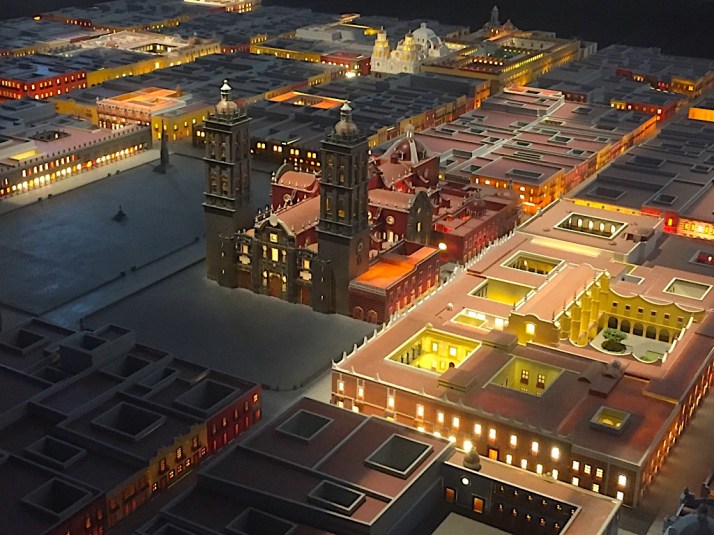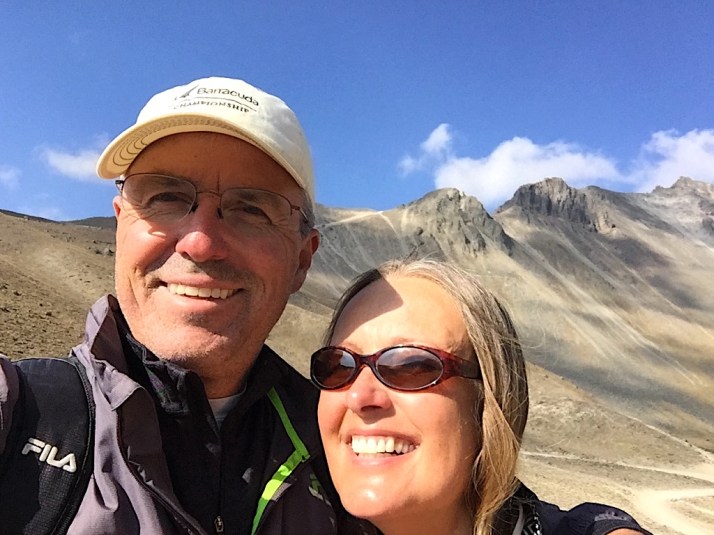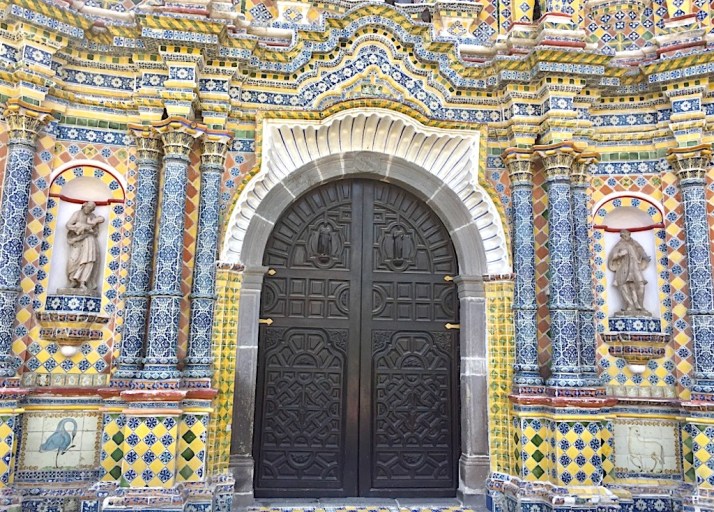After the Easter weekend, we said goodbye to Oaxaca and proceeded to Puebla for the month of April. Puebla, Mexico’s 4th largest city, is a beautiful colonial center, located a couple hours south of Mexico City, amidst the country’s highest mountains.

Model of Puebla Cathedral and Historical Center
In 1531, the Spanish founded Puebla as the first planned city in the New World, conveniently situated between the capital of Mexico City and principal port city of Veracruz. Given its central location, Puebla makes a good base for one-day and overnight trips to Mexico City and the nearby Mexican states of Tlaxcala and Veracruz.

The Great Pyramid of Cholula and Hilltop Church
A worthy half-day trip just outside of Puebla is the charming town of Cholula. Besides its famous hot sauce, Cholula is best known for its great pyramid, which is the largest by volume ever constructed. Since the pyramid was made mostly of adobe mud bricks, it has weathered into a rounded tree-covered hill, laced with narrow tunnels, and topped by a gleaming yellow church.

Inside a Volcano, Nevado de Toluca, Mexico’s 4th highest peak
Puebla sits at an altitude of over 7,200 feet (2,195 m), and has good access to Mexico’s tallest mountains. The six highest peaks in Mexico are volcanoes, and all are located less than 100 miles (160 km) from Puebla. Over the course of the month, we hope to visit and hike as many as we can.

El Popo Puffing, from Pyramid of the Sun, Teotihuacán, September 2017
Back on September 19, 2017, while inside a Mexico City movie theater, we experienced a tragic 7.1 magnitude earthquake, centered just 34 miles (55 km) south of Puebla. In this geologically dynamic area, Mexico’s only active volcano Popocatépetl (El Popo) occasionally puffs plumes of gas and ash from Puebla’s western horizon.

Rosary Chapel Dome, Puebla
Puebla is also a designated UNESCO World Heritage Site, and remains one of the five most important colonial cities in Mexico. Known as the cradle of Mexican baroque architecture, Puebla is the largest and best-preserved baroque city in Mexico and the Western Hemisphere.

Talavera Pottery, Taller Uriarte, Puebla
In Puebla, the ornate churches and other buildings are accented with gold leaf and local talavera ceramic tile. Hand-painted in cobalt blue and other natural colors, the tiles decorate the city’s church domes and facades, and trim many of its buildings, gardens, and dining tables.

Templo San Francisco Acatepec, Puebla
After a fun and interesting month in Oaxaca, we have proceeded to our new home of Puebla for the month of April. With its convenient and elevated location close to many of the country’s most interesting sites and highest mountain peaks, this beautiful colonial city should make an excellent base for exploring this pleasant and active part of Mexico.

Good Friday Silent Procession, Oaxaca
Feature Image: Puebla Cathedral twin towers (Mexico’s tallest) and Fountain of St. Michael (Puebla’s Patron Saint)

Looks like another Mexican city that I need to put on our “must visit” list! The tile work on the facade of the Templo San Francisco Acatepec is amazing. Have you seen any evidence of the earthquake? I hope, despite Puebla’s proximity to the epicenter, that it came out relatively unscathed (and not too much was baroque 🙂 ).
LikeLiked by 1 person
Hi Janis, As you know, I love baroque jokes, and yours is a good one. Unfortunately, I have seen extensive earthquake damage around Puebla, most notably in the church facades, towers and interiors. The tiled facade at Acatepec is stunning. As most church entrances face west, I need to go back in the afternoon to see it again and take some better photos. As for Puebla, it isn’t on everyones “must visit” list, but its combination of history, architecture, and mountain hiking make it an ideal place for us to spend a month.
LikeLiked by 1 person
I’m sorry that that beautiful city has experienced damage. When I saw your picture of the ornate Rosary Chapel Dome, I had hoped that they had escaped harm. It’s odd how sometimes places that are closer to the epicenter of an earthquake can have less damage than places further away.
LikeLiked by 1 person
Thankfully, I did not see any structural damage inside the Rosary Chapel. The exterior plaster is broken and the arched bell tower is braced with timbers. I would say that at least half of Puebla’s many church towers are braced, as are several of the interior church arches. Puebla may have been spared some of the earthquake damage due to its more compacted volcanic soil conditions compared to Mexico City’s soft lakebed sediments.
LikeLike
Puebla looks to be a really interesting and attractive place. I’m looking forward to reading more about your explorations there.
LikeLiked by 1 person
Hi Sue & Dave, I have been fascinated with Puebla, since I arrived. I can’t remember a time when I have been more in awe. The mountain scenery, exquisite churches, and even the everyday places have really taken my breath away. Cheers to you guys!
LikeLike
Puebla looks beautiful! I love how you are spending a month at each location. I’d love to do that someday, as I think that amount of time allows us to really get to know a place. There’s only so much you can absorb in a week!
LikeLiked by 1 person
So true, Ann! When we decided to travel one month in each place, it was because we really felt rushed and unfulfilled making shorter trips. We are so fortunate to have the time now to slow down and smell the roses, investigate in-depth the things we are interested in, and even take a few days off if we feel like it.
LikeLiked by 1 person
Looking forward to some interesting posts from Puebla, Joe. A wonderful combination of history, architecture and adventure.
I was reminded of your post about the mayan civilization while watching the movie Apocalypto. That must have been the way the entire civilization was wiped out without a trace. Wars among the tribes must have dwindled their numbers and then the christian missionaries would have taken control of the land.
LikeLiked by 1 person
Thanks for reminding me of that great movie, Deepa. As you say, there is a lot of truth to the theory of the political demise of the Mayan civilization. I also think that related environmental factors (drought, deforestation, and mismanagement of resources) also played a role. It still remains one of history’s great mysteries.
LikeLike